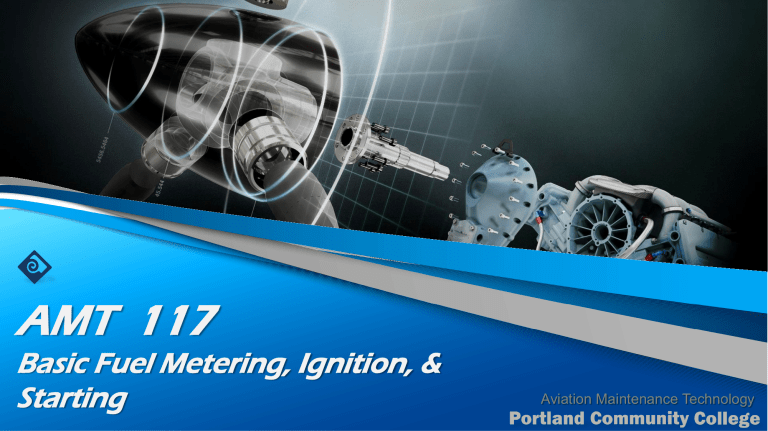
AMT 117 Basic Fuel Metering, Ignition, & Starting Aviation Maintenance Technology Aviation Maintenance Technology Contents Systems Fuel Metering Ignition Systems Starting Systems Aviation Maintenance Technology Fuel Metering - Introduction: - The purpose of carburetion, or fuel metering, is to provide the combustible mixture of fuel and air necessary for the operation of an engine. - The carburetor consists essentially of a main air passage through which the engine draws its supply of air, mechanisms to control the quantity of fuel discharged in relation to the flow of air, and a means for regulating the quantity of FIA mixture delivered to the engine cylinders. - In the float-type carburetor, atmospheric pressure in the fuel chamber forces fuel from the discharge nozzle when the pressure is reduced at the venturi tube. - Thus flow of air passes through the venturi of the carburetor and causes the reduction of pressure in the venturi which, in turn, causes the fuel to be sprayed from the discharge nozzle. Aviation Maintenance Technology Fuel Metering – Carbureted Fuel Metering System Aviation Maintenance Technology Fuel Metering – Carbureted Fuel Metering System Aviation Maintenance Technology Fuel Metering – Engine Controls Aviation Maintenance Technology Fuel Metering - Carburetor Shortcomings (Carb Icing) - When fuel is discharged into the low-pressure area in the carburetor venturi, the fuel evaporates rapidly. - This evaporation of the fuel cools the air, the walls, and the water vapor. - If the humidity (moisture content) of the air is high and the metal of the carburetor is cooled below 32°F [0°C], ice forms and interferes with the operation of the engine. - The fuel-air passages are clogged, the mixture flow is reduced, and the power output drops. - Eventually, if the condition is~ not corrected, the drop in power output may cause engine failure. - Ice formation in the carburetor may be indicated by a gradual loss of engine speed, a loss of MAP, or both, without change in the throttle position. Aviation Maintenance Technology Fuel Metering – Carburetor Shortcomings Aviation Maintenance Technology Fuel Metering - Fuel Injection Systems: - Fuel injection is the introduction of fuel or a fuel-air (F/A) mixture into the induction system of an engine or into the combustion chamber of each cylinder by means of a pressure source other than the pressure differential created by airflow through the venturi of a carburetor. - The usual pressure source is an injection pump, which comes in several types. - A fuel injection carburetor discharges the fuel into the airstream at or near the carburetor. - A fuel injection system discharges the fuel into the intake port of each cylinder just ahead of the intake valve or directly into the combustion chamber of each cylinder. Aviation Maintenance Technology Fuel Metering – Differing Injection Methods Injection Carburetor Continuous Flow Injection Direct Injection Aviation Maintenance Technology Fuel Metering - Fuel Injection Advantages: 1) Freedom from vaporization icing, thus making it unnecessary to use carburetor heat except under the most severe atmospheric conditions 2) More uniform delivery of F/A mixture to each cylinder 3) Improved control of F/A ratio 4) Reduction of maintenance problems 5) Instant acceleration of engine after idling, with no tendency to stall 6) Increased engine efficiency Aviation Maintenance Technology Fuel Metering – Bendix RSA Fuel Injection System Aviation Maintenance Technology Fuel Metering – Teledyne Continental Fuel Injection System Aviation Maintenance Technology Ignition Systems - Introduction: - During the second event, which is the compression stroke, the crankshaft continues to rotate and the piston moves upward to compress the fuel-air (F/ A) mixture. - As the piston approaches the top of its stroke within the cylinder, an electric spark jumps across the points of the spark plugs and ignites the compressed F/A mixture. - The electric spark jumps between the electrodes (points) of a spark plug installed in the cylinder head or combustion chamber of the engine cylinder. - The ignition system furnishes sparks periodically to each cylinder at a certain position of piston and valve travel. Aviation Maintenance Technology Ignition Systems - Battery Ignition Systems: - A few aircraft and most automobiles use a battery ignition system which has a battery or generator rather than a magneto as its source of energy. - In the battery ignition system, a cam, which is driven by the engine, opens a set of points to interrupt the flow of current in a primary circuit. - The resulting collapsing magnetic field induces a high voltage in the secondary of the ignition coil, which is directed by a distributor to the proper cylinder. Aviation Maintenance Technology Ignition – Basic Magneto System Aviation Maintenance Technology Ignition – Basic Magneto System Aviation Maintenance Technology Ignition Systems - Spark Plugs: - The spark plug is the part of the ignition system in which the electric energy of the high-voltage current produced by the magneto, or other high-tension device, is converted to the heat energy required to ignite the F/A mixture in the engine cylinders. - The spark plug provides an air gap across which the high voltage of the ignition system produces a spark to ignite the mixture. Aviation Maintenance Technology Ignition – Spark Plugs Aviation Maintenance Technology Starting Systems - Reciprocating Engine Starters: - The direct-type starter, when electrically energized, provides instant and continuous cranking. - This starter fundamental consists of an electric motor, reduction gears, and an automatic engaging/disengaging mechanism, which is operated through an adjustable-torque overload release clutch. - The engine is therefore cranked directly by the starter. - The motor torque is transmitted through the reduction gears to the adjustabletorque overload release clutch, which actuates a helically splined shaft. - This, in turn, moves the starter w outward, along its axis, and engages the enginecranking jaw. - Then, when the starter jaw is engaged, cranking starts. Aviation Maintenance Technology Starting – Starter Aviation Maintenance Technology Starting – Starter Aviation Maintenance Technology Starting – Starter Aviation Maintenance Technology Starting – Starter Aviation Maintenance Technology Starting – Lycoming Accessory Gearbox Aviation Maintenance Technology End Aviation Maintenance Technology


